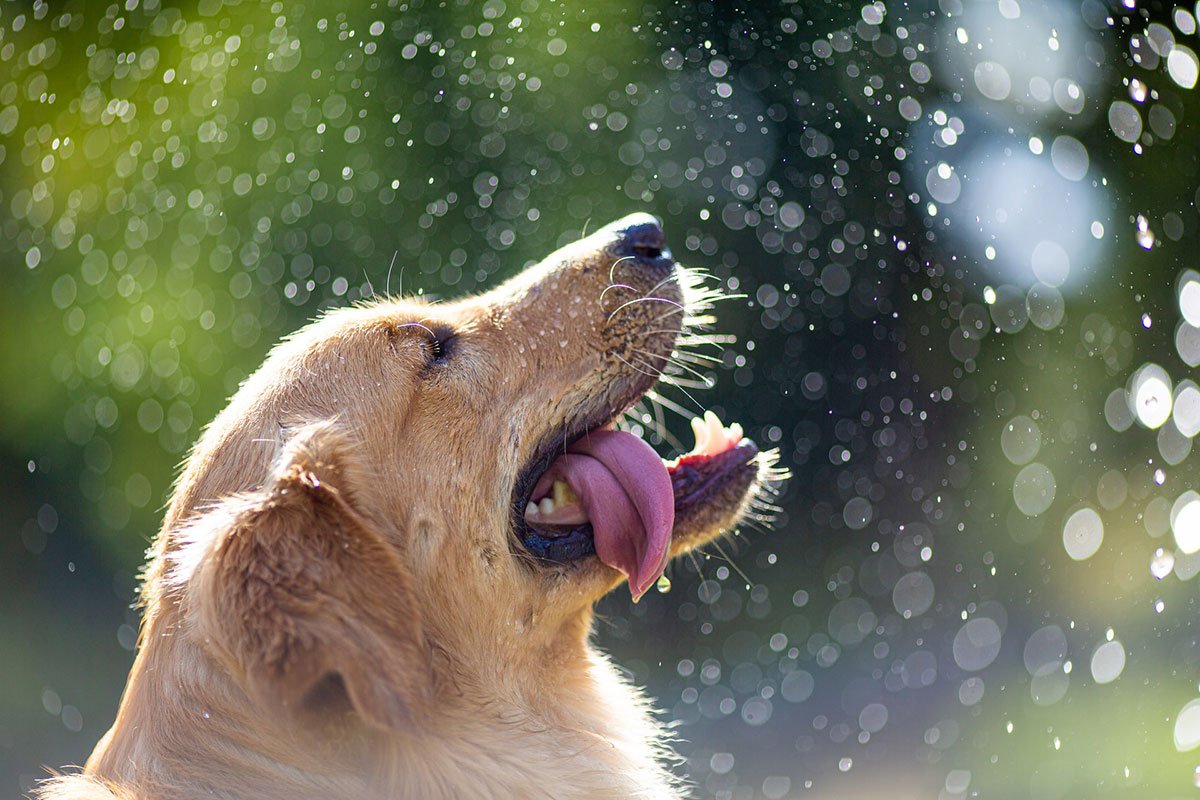Did you know over 60% of American households own a dog? That’s a huge number of 89.7 million furry friends across the country! With so many dogs, effective dog training techniques are crucial for pet owners. In this article, we’ll look at 5 effective dog training methods. These can change your pup’s behavior and make them a well-mannered, happy friend.
Key Takeaways
- Discover the power of positive reinforcement in dog training
- Learn how clicker training can improve communication with your dog
- Understand the step-by-step process of shaping behavior
- Recognize the importance of consistency, patience, and clear communication
- Explore techniques to create a positive and engaging learning environment for your pup
The Importance of Positive Reinforcement
Positive reinforcement is key to good dog training. We reward good behavior with treats, praise, or other rewards. This encourages dogs to do more of the same. It’s a great way to build trust and motivation, making learning fun for them.
Reward-Based Methods
Reward-based training focuses on good behavior, not bad. When dogs do what we want, we give them something they like. This could be a treat, a favorite toy, or praise. It shows them what we want and makes training a positive experience.
Building Trust and Motivation
Positive reinforcement helps build trust and motivation in dogs. When they learn good behavior gets rewards, they want to please us more. This trust and motivation are crucial for lasting learning. Dogs are more likely to enjoy and remember what they learn.
“Positive reinforcement is the most effective and humane way to train dogs. It builds a strong bond between you and your pup, making training a fun, rewarding experience for both of you.”
Clicker Training: A Powerful Communication Tool
Clicker training is a top-notch way to teach dogs. It uses a small device to mark when a dog does the right thing. This makes it clear what actions are rewarded, speeding up learning.
The “click” sound is key. It lets us talk clearly to our dogs. This makes learning fun for both the dog and the trainer.
The clicker links the dog’s action to the reward. This immediate feedback is key. It helps dogs learn by showing them how their actions affect things.
Clicker training is great for teaching complex things. It helps dogs learn even the smallest steps towards a big behavior.
This method is positive and builds trust. It makes the dog want to learn and please. This strengthens the bond between dog and trainer.
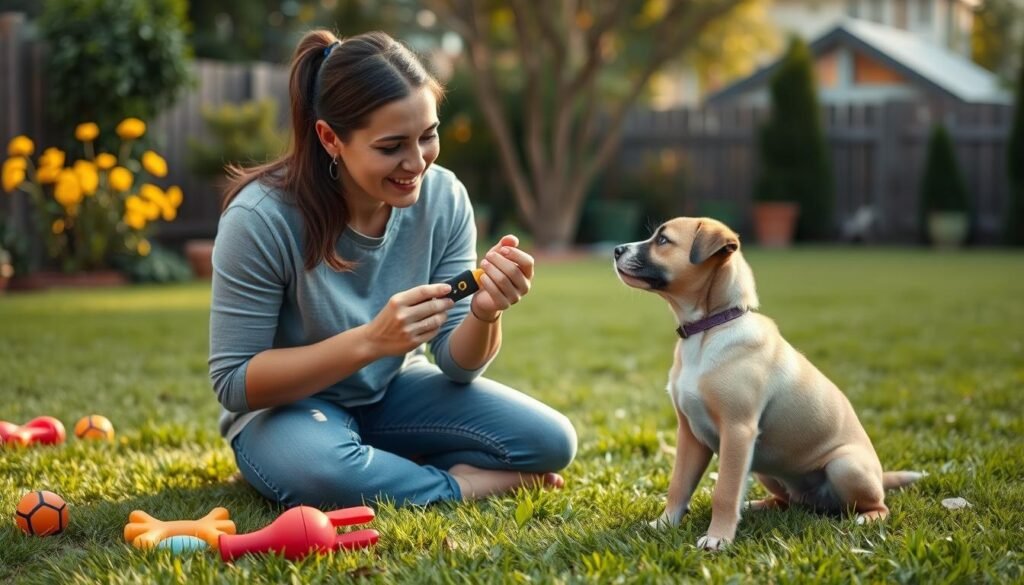
Using clicker training and marker training makes training better. It makes learning fun and effective. These tools help us understand and work with our dogs better.
5 Dog Training Techniques
Learning to train dogs requires many techniques. Each one is designed to grab your dog’s attention, build trust, and shape their behavior. Clicker training is well-known, but there are other effective methods too.
Marker Training: Capturing the Moment
Marker training is like clicker training but uses a sound or word to tell your dog they did something right. Using a word like “yes” helps mark the exact moment they deserve a reward. This makes them connect their actions with the reward they get.
Shaping Behavior Step-by-Step
Shaping behavior helps build complex actions by rewarding small steps towards the goal. It’s not about teaching a trick in one go. Instead, it breaks it down into smaller steps, rewarding each one to guide your dog to the end.
- Start with a simple behavior and gradually increase the criteria for the reward.
- Reward even the slightest movements or attempts that bring your dog closer to the end goal.
- Be patient and persistent, allowing your dog to learn at their own pace.
By mastering marker training and shaping behavior, you’ll open up new possibilities in your dog’s training. You’ll capture the moment and build complex skills step-by-step.
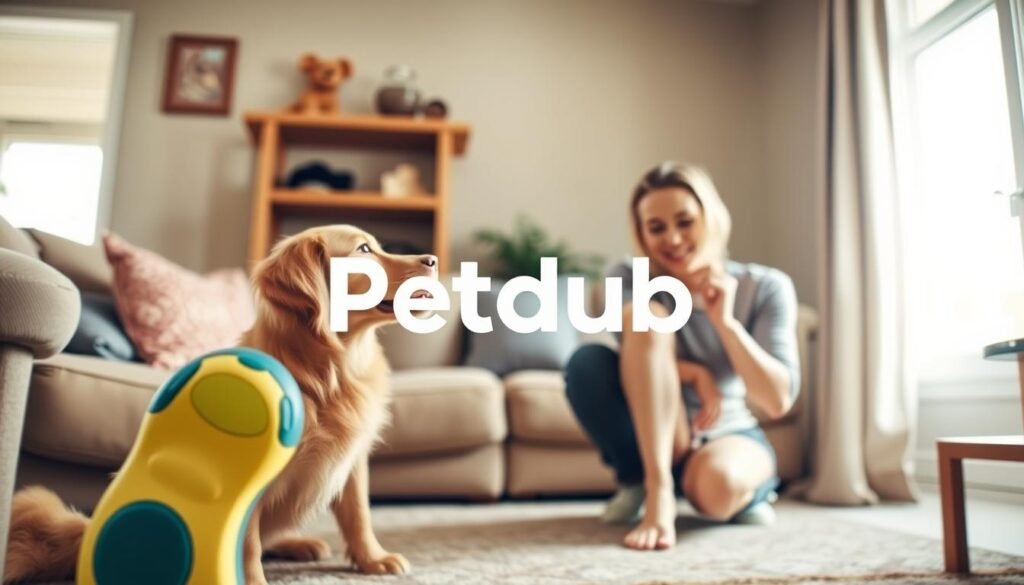
“The key to successful dog training is finding the right balance between challenging your pup and keeping them motivated. With the right techniques, you can transform even the most stubborn canine into a well-behaved companion.”
Consistency: The Key to Successful Training
Effective dog training is all about being consistent. By setting clear boundaries and expectations, we can help our dogs learn faster. They will also keep up with the behaviors we teach them.
Setting Clear Boundaries
It’s key to establish clear boundaries for your dog’s understanding and your training success. When you give consistent, clear guidelines, your dog feels secure. They know what’s expected of them, which helps avoid confusion and strengthens the behaviors you want.
- Clearly communicate your rules and expectations to your dog.
- Enforce these boundaries consistently, without exception, in all situations.
- Use positive reinforcement to reward your dog when they adhere to the established guidelines.
Consistency is the base of successful dog training. By sticking to a clear and steady approach, you’ll see big improvements in your dog’s learning and behavior.
“Consistency is not about perfection, it’s about establishing a reliable framework that your dog can thrive within.”
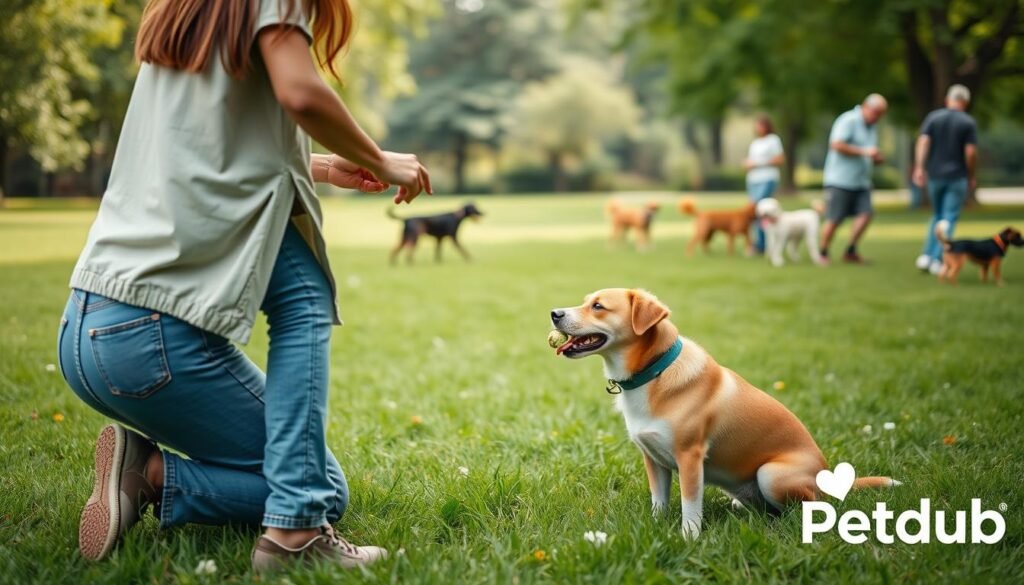
| Consistent Training | Inconsistent Training |
|---|---|
| Clearly defined rules and expectations | Unclear or changing guidelines |
| Positive reinforcement used across all situations | Inconsistent use of rewards and punishment |
| Unwavering adherence to training methods | Frequently changing training approach |
| Steady progress in desired behaviors | Confusion and lack of progress |
By embracing consistency in your dog training, you’ll create a stable and trustworthy environment. Stay committed, and you’ll see your dog become well-trained and well-behaved.
The Art of Patience and Clear Communication
Effective dog training needs patience and clear communication. As pet owners, we must guide our dogs patiently. We break down tasks into smaller steps and give feedback and rewards often. This way, our dogs feel safe and ready to learn.
Clear communication is key in dog training. We must tell our dogs what we want in a way they can understand. We use words, hand signals, and rewards to teach them.
- Break down training goals into smaller, achievable steps.
- Provide immediate and consistent feedback through praise, treats, or other rewards.
- Use clear, concise language and be patient when introducing new commands or behaviors.
- Adapt your training approach to your dog’s individual learning style and personality.
- Celebrate small victories and progress along the way to keep your dog motivated and engaged.
“The key to successful dog training is to remember that patience and clear communication are two sides of the same coin. By mastering these essential skills, you’ll unlock the full potential of your canine companion.”
Patience and clear communication are the heart of dog training. By following these principles, we make learning fun for our dogs. This builds a strong bond and prepares them for a lifetime of success.
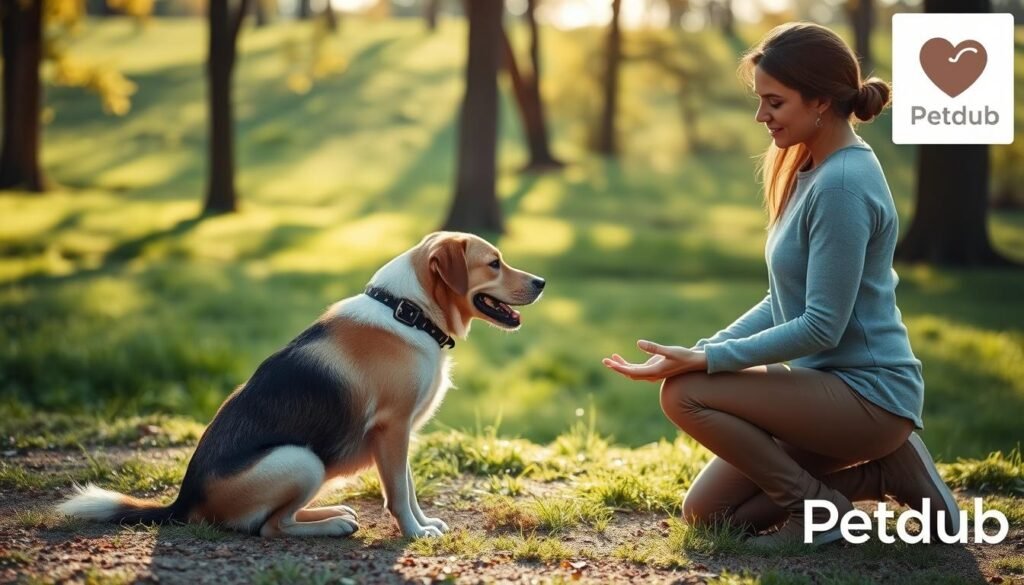
Creating a Positive Learning Environment
Creating a positive learning space is key for dog training success. It means handling distractions, making training fun, and building trust and teamwork. This helps our dogs learn better and enjoy the process.
Managing Distractions
Reducing distractions is crucial for a good learning space. We need to remove or control things that might distract our dogs, like loud noises or bright lights. A calm and focused area helps our dogs stay on track and listen to us better.
Making Training Sessions Fun
We can also make training fun and rewarding for our dogs. Using their favorite treats or toys can make a big difference. This approach keeps them excited and eager to learn, strengthening our bond.
- Use positive reinforcement techniques to reward desired behaviors
- Incorporate play and interactive games into training sessions
- Adjust the pace and difficulty of training to match your dog’s abilities and keep them engaged
By focusing on a positive learning environment, we help our dogs succeed. They gain the skills and confidence they need to do well.
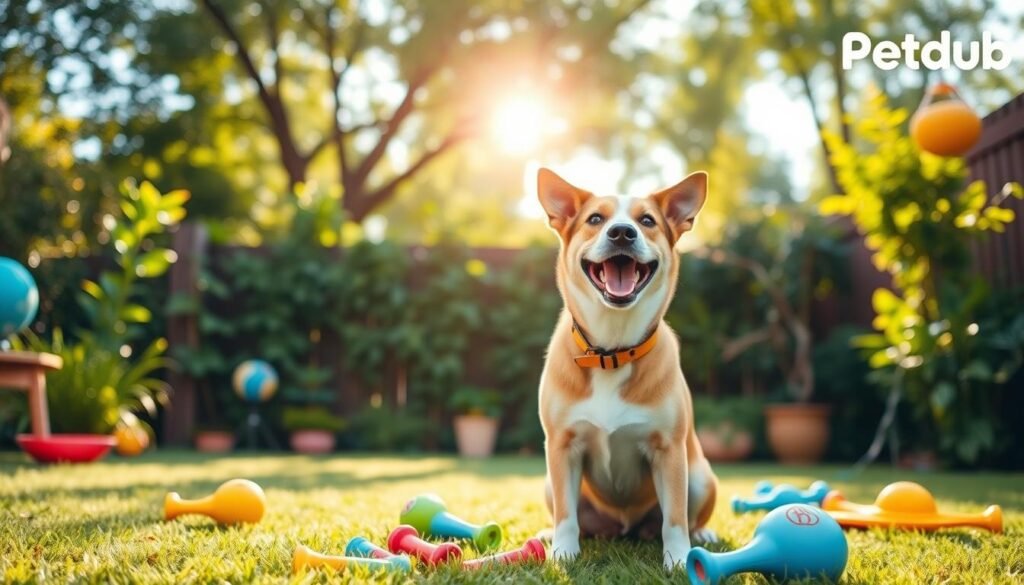
Tailoring Techniques to Your Dog’s Personality
Dog training isn’t a one-size-fits-all approach. Each dog is special, with its own personality, learning style, and what motivates it. By watching our dogs and adjusting the training techniques to fit their needs, we can make training more effective. This also strengthens our bond with them.
Some dogs love solving puzzles, while others enjoy physical activities. Hounds are great at sniffing out things, while sporting dogs love to fetch. Toy breeds do well with gentle training and positive feedback. Working dogs do best with tasks that challenge them. Knowing our dog’s personality helps us create a training plan that works for them.
- Watch how your dog naturally acts and what they like.
- Try different training methods to see what works best.
- Change your training approach as your dog grows and changes.
By tailoring our training to our dog’s personality, we build a stronger bond. We also ensure a positive learning experience for both of us. With patience, creativity, and a flexible approach, we can help our dogs reach their full potential. This creates a rewarding, lifelong partnership.
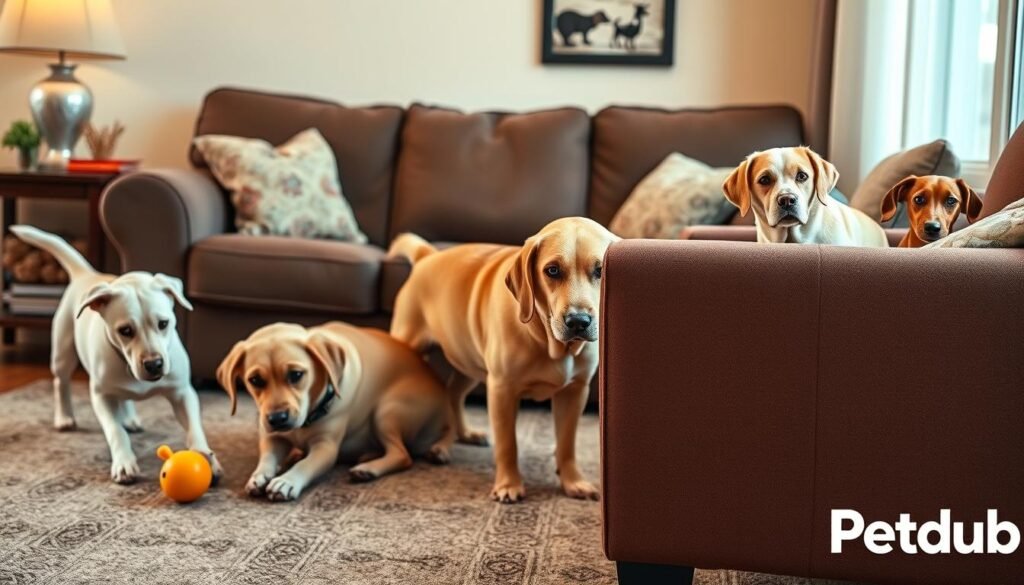
“The key to successful dog training is understanding and embracing the individual needs of each dog.”
Incorporating Mental Stimulation
Physical exercise is key for our dogs, but mental stimulation is just as vital. Engaging their minds with training, puzzles, and games keeps them happy and healthy. It prevents boredom and unwanted behaviors, and helps them learn and grow.
Puzzles and Interactive Games
Puzzles and interactive toys are great for a dog’s mind. They challenge problem-solving skills and mimic natural foraging. Options like snuffle mats, treat-dispensing toys, puzzle feeders, and hide-and-seek games keep dogs busy and happy.
Adding these activities to our dogs’ routines boosts their cognitive skills and strengthens our bond. The benefits of mental stimulation for dogs are huge. It fights boredom, stress, and promotes a happy, well-rounded life.
| Mental Stimulation Activity | Benefits |
|---|---|
| Snuffle Mats | Encourages natural foraging behaviors, reduces stress, and provides mental challenge. |
| Treat-Dispensing Toys | Promotes problem-solving skills, slows down eating, and keeps dogs engaged. |
| Puzzle Feeders | Stimulates the mind, prevents boredom, and makes mealtime more rewarding. |
| Hide-and-Seek Games | Enhances the human-dog bond, provides physical and mental exercise, and encourages natural hunting instincts. |
By mixing up mental stimulation activities, we ensure our dogs live a full, happy life. They get both physical and mental exercise.
“A bored dog is a problem dog. Providing mental stimulation is just as important as physical exercise for our canine companions.”
Building a Strong Bond Through Training
Creating a strong bond with our dogs starts with good dog training. Working together, communicating well, and celebrating wins helps us connect deeper. This connection makes our dogs happier and more enjoyable to be around.
Training is more than teaching tricks; it’s about building trust and understanding. Being patient, positive, and flexible helps us create a safe space for learning. This space is where a strong bond grows.
Positive reinforcement, clicker training, and fun games make our dogs feel secure and excited to learn. Overcoming challenges and mastering new skills together strengthens our bond. This bond is based on respect and loyalty.
“The foundation of a strong bond with your dog is built through consistent, positive training. It’s a journey of communication, trust, and shared experiences that bring you closer together.”
Understanding the importance of training in building a strong bond is key. It makes our relationship with our dogs better and more fulfilling. By focusing on this bond, we open up a world of happiness, friendship, and shared adventures that will make our lives better for years.
Common Training Challenges and Solutions
Starting dog training can sometimes face obstacles like stubborn behaviors. Knowing why these issues happen and how to fix them helps us move forward. This way, we can keep improving our training efforts.
Addressing Stubborn Behaviors
Stubbornness in dogs is a common problem. It might be due to lack of motivation, poor training, or health issues. To tackle these training challenges, we need to:
- Find the cause: Check if the stubbornness comes from lack of motivation, bad training, or health problems.
- Use positive methods: Training that rewards good behavior, like clicker training, works well for stubbornness.
- Keep them engaged: Use puzzles and games to keep your dog’s mind active and interested in training.
- Be consistent: Set clear rules and make sure everyone in the family follows them.
- Get professional help: If stubbornness persists, a certified dog trainer can offer valuable advice and support.
Understanding and addressing the reasons behind stubbornness can help. This way, we can build a strong, positive relationship with our dogs.
Celebrating Small Wins and Progress
Training our dogs is a rewarding journey. It’s key to celebrate the small wins and progress we make. Every successful step shows our hard work, patience, and trust with our dogs.
Every milestone, like a “sit” command or a new trick, is worth celebrating. Praise and recognition help solidify good behaviors. This keeps us both motivated and excited to learn more.
By focusing on the positive, we strengthen our bond with our dogs. It also helps us feel accomplished. Celebrating progress keeps our dogs eager to learn and face new challenges.
“The journey of a thousand miles begins with a single step.” – Lao Tzu
Let’s cherish the small victories in dog training. They are the foundation for great achievements. Celebrating progress keeps us inspired and our dogs engaged, making every session rewarding.
- Recognize and praise your dog’s achievements, no matter how small
- Reinforce positive behaviors to solidify the training progress
- Stay motivated and keep your dog engaged by focusing on the positive
- Appreciate the journey and the milestones along the way
Remember, celebrating progress is crucial for a positive training environment. By embracing small wins, we build a strong bond and long-term success with our dogs.
Seeking Professional Help When Needed
While the dog training techniques we’ve covered can be highly effective, there may come a time when seeking the guidance of a professional is beneficial. Certified dog trainers and behavior consultants can provide personalized support. They help us navigate more complex training challenges or behaviors.
Certified Dog Trainers
Certified dog trainers are experts who have undergone rigorous training and certification. They ensure they have the knowledge and skills to work with dogs of all breeds and temperaments. They can help us develop a customized training plan, address specific behavioral issues, and provide valuable insights into our pet’s unique needs.
Behavior Consultants
Behavior consultants are highly trained professionals who specialize in understanding and modifying dog behavior. These experts can assess the underlying causes of problematic behaviors, such as aggression or anxiety. They develop a comprehensive plan to address them. By working with a behavior consultant, we can gain a deeper understanding of our dog’s needs and learn effective techniques to create a more harmonious relationship.
Seeking professional help, whether from certified dog trainers or behavior consultants, can be a game-changer in our dog’s training journey. These experts can provide the guidance and support we need to overcome challenges. They help our furry friends reach their full potential.
| Certified Dog Trainers | Behavior Consultants |
|---|---|
| Experts in dog training techniques | Specialize in understanding and modifying dog behavior |
| Develop customized training plans | Assess underlying causes of behavioral issues |
| Help address specific behavioral challenges | Create comprehensive plans to address problematic behaviors |
| Provide valuable insights into a dog’s unique needs | Help us gain a deeper understanding of our dog’s needs |
Conclusion
As we wrap up our look at 5 dog training techniques, we’re sure these methods can change our dogs for the better. They can become well-behaved, happy, and loyal friends. Positive reinforcement, clicker training, and shaping behavior are key. They help us build a strong bond with our dogs and teach them important values.
These 5 techniques are great for any dog, whether it’s a puppy or an adult with specific issues. They offer a wide range of tools to fit your dog’s unique needs and learning style. By making training fun and positive, we can help our dogs reach their full potential.
Let’s celebrate the small victories and the joy of training our dogs. If you need help, don’t be afraid to ask a certified trainer or behavior consultant. They can offer expert advice and tailored solutions. Together, we can make sure our dogs are happy and our bond with them grows stronger, one training session at a time.
Training your dog: 5 excellent techniques
FAQ
What is positive reinforcement in dog training?
Positive reinforcement rewards our dogs with treats or praise for good behavior. This builds trust and motivation, creating a positive learning space.
How does clicker training work?
Clicker training uses a device to mark good behavior. It helps dogs quickly learn what actions are rewarded, speeding up training.
What is shaping behavior in dog training?
Shaping behavior rewards small steps towards a goal. It’s a step-by-step way to teach our dogs new skills efficiently.
Why is consistency important in dog training?
Consistency is key for effective training. Clear rules and consistent training help dogs learn faster and remember what they’ve learned.
How does patience and clear communication benefit dog training?
Patience and clear communication are vital. They allow us to guide our dogs through learning, breaking tasks into steps and rewarding them often. This helps them understand what we expect.
How can we create a positive learning environment for our dogs?
A positive learning space is crucial. It means managing distractions, making training fun, and fostering trust and cooperation.
How can we tailor training techniques to our dog’s personality?
Every dog is different. By observing and tailoring training to their needs, we can make training more effective and strengthen our bond.
Why is mental stimulation important for our dogs?
Mental stimulation is as important as physical exercise. It prevents boredom, reduces bad behavior, and keeps their minds active.
How does dog training help build a strong bond?
Training not only teaches our dogs but also strengthens our bond. Working together, communicating clearly, and celebrating successes deepens our connection.
How can we address stubborn behaviors in our dogs?
Training can face challenges like stubbornness. Understanding the reasons and using the right methods can help us overcome these and continue training.
When should we seek professional help for dog training?
Sometimes, professional help is needed. A certified trainer or behavior consultant can offer personalized support and help with complex challenges.



